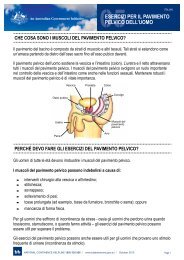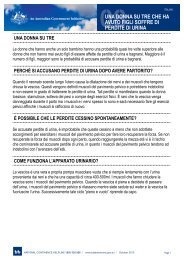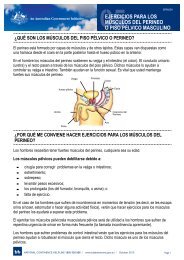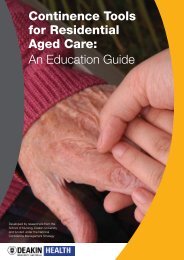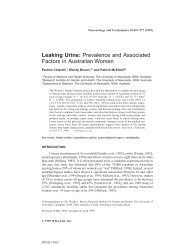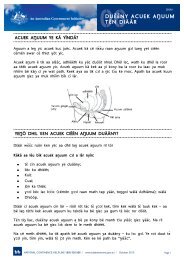Pharmacy Continence Care - Bladder and Bowel Website
Pharmacy Continence Care - Bladder and Bowel Website
Pharmacy Continence Care - Bladder and Bowel Website
You also want an ePaper? Increase the reach of your titles
YUMPU automatically turns print PDFs into web optimized ePapers that Google loves.
materials, the Pharmacist Training Module <strong>and</strong> the <strong>Pharmacy</strong> Assistant Training Module.<br />
Stage 2 of the <strong>Pharmacy</strong> <strong>Continence</strong> <strong>Care</strong> Program, which is the subject of this report, was<br />
commissioned in late 2004 to review the materials developed in Stage 1, <strong>and</strong> to research<br />
<strong>and</strong> develop a training package <strong>and</strong> strategy to trial <strong>and</strong> evaluate the implementation of the<br />
draft <strong>Pharmacy</strong> <strong>Continence</strong> <strong>Care</strong> Program by community pharmacies.<br />
The <strong>Pharmacy</strong> <strong>Continence</strong> <strong>Care</strong> Program is intended to establish a role for pharmacists in<br />
continence care, a role that has not been formally developed <strong>and</strong> articulated prior to this.<br />
The Program has been designed for the pharmacist to assist in the identification of people<br />
who are at risk of incontinence, <strong>and</strong> to provide continued support <strong>and</strong> management to<br />
people with the condition. The Program is to enable the pharmacist to identify, advise,<br />
counsel <strong>and</strong>/or refer <strong>and</strong> promote continence awareness to people with or at risk of<br />
incontinence.<br />
1.2 Stage 2 <strong>Pharmacy</strong> <strong>Continence</strong> <strong>Care</strong> Program<br />
The second stage of the <strong>Pharmacy</strong> <strong>Continence</strong> <strong>Care</strong> Project (PCCP), which commenced in<br />
September 2004, was to design, implement <strong>and</strong> evaluate a pilot program to provide<br />
information <strong>and</strong> training to pharmacists <strong>and</strong> pharmacy assistants in community pharmacies,<br />
<strong>and</strong> to establish draft st<strong>and</strong>ards for a national sustainable <strong>and</strong> cost-effective accreditation<br />
program based on the Quality <strong>Care</strong> <strong>Pharmacy</strong> Practice (QCPP) st<strong>and</strong>ards <strong>and</strong> requirements.<br />
The project is considered by the <strong>Pharmacy</strong> Guild to be important to all areas of pharmacy,<br />
governments, <strong>and</strong> people affected by incontinence. The Guild considers the project offers<br />
the potential for pharmacists <strong>and</strong> pharmacy assistants to be more formally recognised in<br />
continence care <strong>and</strong> for the contribution they are able to make to the quality of life to those<br />
whose incontinence is undiagnosed, poorly managed or under treated. The project is to<br />
develop st<strong>and</strong>ards for possible incorporation into the Quality <strong>Care</strong> <strong>Pharmacy</strong> Practice<br />
program <strong>and</strong> would enable interested pharmacies to participate in a st<strong>and</strong>ardised <strong>and</strong><br />
accredited quality care service in continence care.<br />
This project (Stage 2) had a specific service development purpose rather than research per<br />
se. The research component required was a measurement of the health <strong>and</strong> economic<br />
outcomes of the program <strong>and</strong> an evaluation of the effectiveness <strong>and</strong> cost-effectiveness of<br />
the intervention. The agreed project design aimed to demonstrate the outcomes <strong>and</strong><br />
benefits of the training materials, the training methodology, the pharmacy interaction with<br />
consumers, the business benefit to pharmacies providing a continence care service, <strong>and</strong> the<br />
health <strong>and</strong> other benefits to consumers, <strong>and</strong>, depending on the outcomes of the project, to<br />
consider the potential to demonstrate to government the cost-effectiveness of including<br />
pharmacists in the National <strong>Continence</strong> Management Strategy.<br />
The project had four core tasks:<br />
• to develop training <strong>and</strong> resource materials<br />
• to develop <strong>and</strong> implement a training program<br />
• to evaluate the outcomes of pharmacy-provided continence care following the training<br />
program<br />
• to recommend on the potential for implementation of the program as a participatory <strong>and</strong><br />
accredited quality care program for community care pharmacy.<br />
The central research questions were the extent to which:<br />
• participation in the training resulted in behaviour change in pharmacists <strong>and</strong> pharmacy<br />
assistants<br />
Final Report<br />
2<br />
NOVA Public Policy<br />
<strong>Pharmacy</strong> <strong>Continence</strong> <strong>Care</strong> Project



